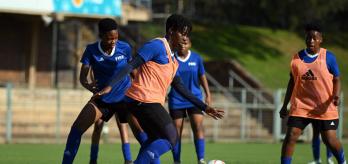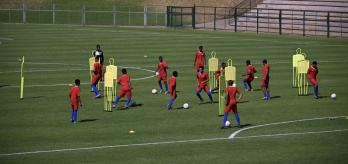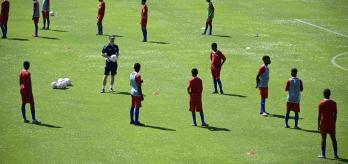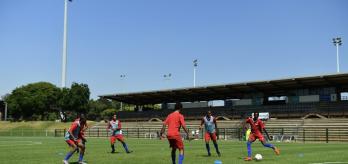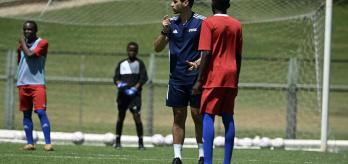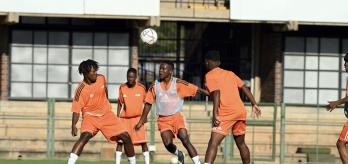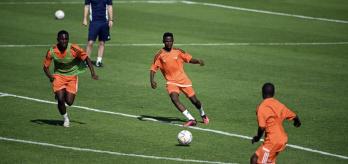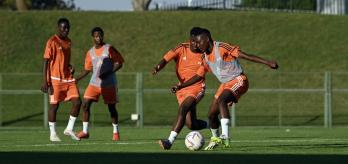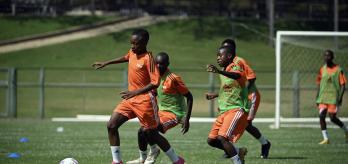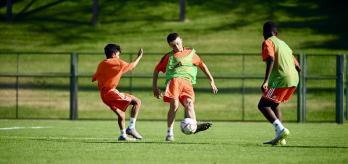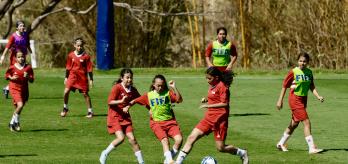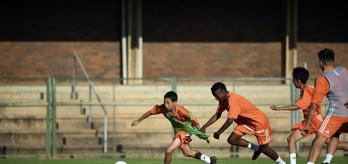Methodology
The intention: What is practised?
The objective of this attack v. defence game is to enhance a unit’s ability to build and progress play from their goal kick, starting with a 2v1 numerical advantage in their defensive zone. The exercise homes in on unit actions in the build-up phase, such as creating passing lines to help to bypass the press and play forwards. The unit are tasked with collectively recognising when players in certain zones are under pressure and making movements to provide them with an outlet. For example, midfielders can drop to receive and draw in opponents to give forwards more space in which to receive. The unit are asked to support each other at all times to progressively link the three zones and identify opportunities to move between zones to provide numerical advantages when possible.
The scale: For whom is this relevant?
This attack v. defence exercise is focused on a unit level and homes in on playing out from the back against a high block. The game is particularly relevant to the central players in each line of the build-up, from the goalkeeper through to the forwards. Starting with a pass out from the goalkeeper, the two centre-backs must either link with the two central midfielders or play the ball directly into the centre-forward. The opposition replicates a high block in which only one front player presses at a time, whilst players in central areas may adopt a player-to-player marking strategy. The game is position-specific, with centre-forwards dropping to receive or trying to get in behind, and midfielders opening up passing lines from defence or making late runs to support the forward.
The practice type: How is the practice designed?
The exercise involves an attack v. defence game that is focused in a team’s defensive third in the build-up phase. The narrow nature of the exercise area means that play is channelled through the thirds centrally, and the emphasis is placed on passing through the centre of midfield or bypassing the press and directly playing into the centre-forward. The offside rule applies, which requires players to pay attention to their positioning and the timing of their runs. Additionally, to force players to play forwards, they are unable to play the ball back into the build-up zone. Lastly, the three zones provide players with a reference about which actions are required in each zone.
Session plan
Organisation
-
Mark out a 60m x 20m exercise area and divide it into three zones widthways.
-
Position a full-size goal at either end of the exercise area.
-
Place a goalkeeper in each goal.
-
Split the group into 1 team of 5 (blues) and 1 team of 4 (oranges).
-
Set up the blues up in a 2-2-1 formation and arrange the oranges in a 1-2-1 system.
Explanation
-
The exercise starts with the blues’ goalkeeper in possession.
-
The blues try to progress the ball through the zones and score in the oranges’ goal.
-
The 3 players in the respective build-up zones cannot leave the zone. The other players are free to move between zones.
-
Once the ball leaves the build-up zone, it cannot be played back into it.
-
If the oranges win the ball, the teams swap roles immediately.
-
The offside rule applies, with the halfway line representing the offside line.
-
When a goal is scored or the ball goes out of play, the first coach feeds a ball into a goalkeeper.
Key coaching points
Roles of the coaches
-
First coach: leads the session, coaches the players from their position on the side of the exercise area and feeds new balls into the exercise area.
-
Second coach: coaches and encourages the players from their position on the side of one half of the exercise area.
-
Third coach: coaches and encourages the players from their position on the side of the other half of the exercise area to the second coach.

























